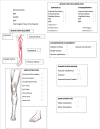Analysis of Doppler ultrasonography and computer tomography angiography for predicting amputation level and re-amputation rate
- PMID: 36276557
- PMCID: PMC9514072
- DOI: 10.14744/nci.2021.25665
Analysis of Doppler ultrasonography and computer tomography angiography for predicting amputation level and re-amputation rate
Abstract
Objective: Peripheral arterial disease of the lower extremities is one of the most common causes of non-traumatic lower extremity amputation. Computed tomography (CT) angiography and Doppler ultrasonography are mainly used to evaluate distal vascular structures. Our objective was to evaluate the predictive efficacy of Doppler ultrasound and CT angiographic radiographic examinations in determining amputation levels and reamputation rates in patients undergoing lower extremity amputation.
Methods: Patients with major or minor amputation at various levels due to lower extremity lesions were included in the study. Standard demographic information, clinical accompanying diseases, reamputation datas, Doppler ultrasound, and CT angiography radiological evaluation reports were obtained retrospectively from the hospital system records of the patients.
Results: A total of 166 cases including 119 (71.7%) males and 47 (28.3%) females were included in the study. About 36.7% (n=61) cases had amputation at the level of surgery above the knee, 38.6% (n=64) below the knee and 24.7% (n=41) at the level of foot/finger. In patients who underwent amputation above the knee, occlusion was seen at the level of the iliac artery (88.9%), femoral artery (47.8%), and popliteal artery (37%). The rate of occlusion at the level of the popliteral artery in patients with below-knee amputation (59.3%) was found in patients with foot/finger amputation (51.5%) at the levels arteria dorsalis pedis and posterior tibial artery. According to the level of occlusion at all blood flow levels, it was observed that the rate of reamputation was most common in occlusions at the level of popliteal artery.
Conclusion: It was found that radiological data are effective in planning amputation according to blood flow level and does not make any difference per se. It was found that the reamputation rates were related to the determination of the level of blood flow in the primary surgical phase.
Keywords: Amputation; Doppler ultrasound; angiography; limb.
© Copyright 2022 by Istanbul Provincial Directorate of Health.
Conflict of interest statement
No conflict of interest was declared by the authors.
Figures
Similar articles
-
Stenting for peripheral artery disease of the lower extremities: an evidence-based analysis.Ont Health Technol Assess Ser. 2010;10(18):1-88. Epub 2010 Sep 1. Ont Health Technol Assess Ser. 2010. PMID: 23074395 Free PMC article.
-
[Factors determining late patency of aortobifemoral bypass graft].Srp Arh Celok Lek. 1997 Jan-Feb;125(1-2):24-35. Srp Arh Celok Lek. 1997. PMID: 17974352 Serbian.
-
Successful Conservative Treatment of an Acute Arterial Occlusion After Total Knee Arthroplasty: Report of 2 Cases and Review of the Literature.Am J Case Rep. 2022 Apr 24;23:e936295. doi: 10.12659/AJCR.936295. Am J Case Rep. 2022. PMID: 35462393 Free PMC article. Review.
-
Effect of systemic urokinase infusion after lower limb percutaneous transluminal angioplasty on limb salvage rate in patients with late-stage critical limb ischemia.Eur J Vasc Endovasc Surg. 2014 Oct;48(4):414-22. doi: 10.1016/j.ejvs.2014.04.006. Epub 2014 Jun 28. Eur J Vasc Endovasc Surg. 2014. PMID: 24984839 Clinical Trial.
-
Popliteal artery aneurysms. Factors associated with thromboembolism and graft failure.Int Angiol. 2004 Mar;23(1):54-65. Int Angiol. 2004. PMID: 15156131 Review.
Cited by
-
Advances in Vascular Imaging: A Comparative Analysis of Doppler Ultrasound and Multidetector CT for Lower Limb Peripheral Arterial Disease Diagnosis.Cureus. 2024 Jun 19;16(6):e62673. doi: 10.7759/cureus.62673. eCollection 2024 Jun. Cureus. 2024. PMID: 39036173 Free PMC article.
-
The cystic adventitial disease of the popliteal artery: from imaging to histopathology.Rev Assoc Med Bras (1992). 2024 Apr 22;70(3):e20231482. doi: 10.1590/1806-9282.20231482. eCollection 2024. Rev Assoc Med Bras (1992). 2024. PMID: 38656014 Free PMC article. No abstract available.
References
-
- Uccioli L. Advances in the treatment of peripheral vascular disease in diabetes and reduction of major amputations. Int J Low Extrem Wounds. 2011;10:72–4. - PubMed
-
- Izumi Y, Satterfield K, Lee S, Harkless LB. Risk of reamputation in diabetic patients stratified by limb and level of amputation: a 10-year observation. Diabetes Care. 2006;29:566–70. - PubMed
-
- Acar E, Kacıra BK. Predictors of lower extremity amputation and reamputation associated with the diabetic foot. J Foot Ankle Surg. 2017;56:1218–22. - PubMed
-
- Londero LS, Hoegh A, Houlind K, Lindholt J. Major amputation rates in patients with peripheral arterial disease aged 50 years and over in Denmark during the period 1997-2014 and their relationship with demographics, risk factors, and vascular services. Eur J Vasc Endovasc Surg. 2019;58:729–37. - PubMed
LinkOut - more resources
Full Text Sources

